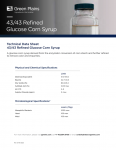New findings challenge studies linking mercury to HFCS - CRA
According to the Corn Refiners Association (CRA), the North American manufacturers of HFCS commissioned independent testing and expert review following recent reports alleging mercury findings in the food and beverage ingredient.
HFCS is found in sweetened beverages, breads, cereals, breakfast bars, lunch meats, yogurts, soups and condiments. On average, Americans consume about 12 teaspoons per day of HFCS.
“The American public can now rest assured that high fructose corn syrup is safe,” said Audrae Erickson, president of the CRA
Confirmation
The CRA said the tests were conducted by the Eurofins Central Analytical Laboratory and results were confirmed by Dr Woodhall Stopford, a leading mercury researcher and director of a toxicology programme at Duke University Medical Center, who added that HFCS does not appear to be a measurable contributor to mercury in foods.
According to the CRA, the Eurofins laboratory received 119 samples of HFCS (42 and 55) in the last two months from all 22 of the US and Canadian HFCS producing facilities.
Eurofins said it found no quantifiable mercury in any of the samples, using accepted methods for quantifiable detection (limit of quantification of 0.005 mg/kg or five parts per billion and a detection limit of two parts per billion).
Study challenged
The Eurofins results challenge a study published in the January issue of Environmental Health, which claimed that mercury was found in nearly 50 per cent of tested samples of commercial HFCS.
Moreover, a recent study by the US Institute for Agriculture and Trade Policy (IATP) claimed that mercury was detected in nearly one-third of 55 brand name food and beverage products, where HFCS is the first or second highest labelled ingredient, including, it claims, products by Quaker, Hershey’s, Kraft and Smucker’s.
The authors concluded that possible mercury contamination of HFCS was not common knowledge within the food industry that frequently uses the sweetener.
‘Cause of contamination’
The IATP’s Dr David Wallinga, coauthor of both studies, explained how HFCS could become tainted with chemical.
He said that for decades, HFCS has been made using mercury-grade caustic soda produced in industrial chlorine plants, with the caustic soda used for, among other things, the separation of the corn starch from the corn kernel.
The use of mercury cells to produce caustic soda can contaminate it, and ultimately HFCS, with mercury, said Wallinga.

















